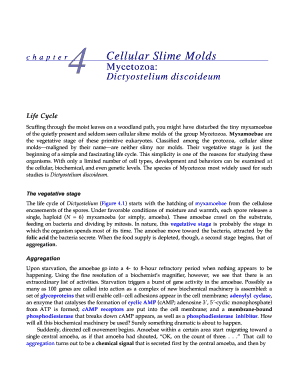Loading

Get Chapter 4. Cellular Slime Molds - D Umn
How it works
-
Open form follow the instructions
-
Easily sign the form with your finger
-
Send filled & signed form or save
How to fill out the Chapter 4. Cellular Slime Molds - D Umn online
This guide provides clear and supportive instructions for users on how to fill out the Chapter 4. Cellular Slime Molds - D Umn form online. Follow the steps outlined to ensure your completion of the document is accurate and efficient.
Follow the steps to successfully fill out the form.
- Press the ‘Get Form’ button to download the Chapter 4. Cellular Slime Molds - D Umn document and open it in your preferred editor.
- Begin by reviewing the introduction text of the document, which provides essential background information pertaining to cellular slime molds.
- Fill in any required fields in the life cycle section, ensuring that you capture key details as specified in the document.
- In the aggregation stage section, detail observations and any relevant findings based on your examination of the slime molds.
- Proceed to the pseudoplasmodium section, where you should elaborate on the characteristics and behaviors observed in the slime mold.
- Complete the culmination section with details about the transformation processes observed in the cellular slime molds.
- If applicable, provide responses in the sexual reproduction section, addressing any rare occurrences documented within your studies.
- Conclude with the culture procedures section by entering notes on how the slime molds were cultured based on provided procedures.
- After filling out all sections, review your inputs for accuracy. You can then save changes, download, print, or share the form as intended.
Complete your documentation online to streamline your research process.
Related links form
Cellular slime molds are eukaryotic microorganisms in the soil. They feed on bacteria as solitary amoebae but conditionally construct multicellular forms in which cell differentiation takes place.
Industry-leading security and compliance
US Legal Forms protects your data by complying with industry-specific security standards.
-
In businnes since 199725+ years providing professional legal documents.
-
Accredited businessGuarantees that a business meets BBB accreditation standards in the US and Canada.
-
Secured by BraintreeValidated Level 1 PCI DSS compliant payment gateway that accepts most major credit and debit card brands from across the globe.


